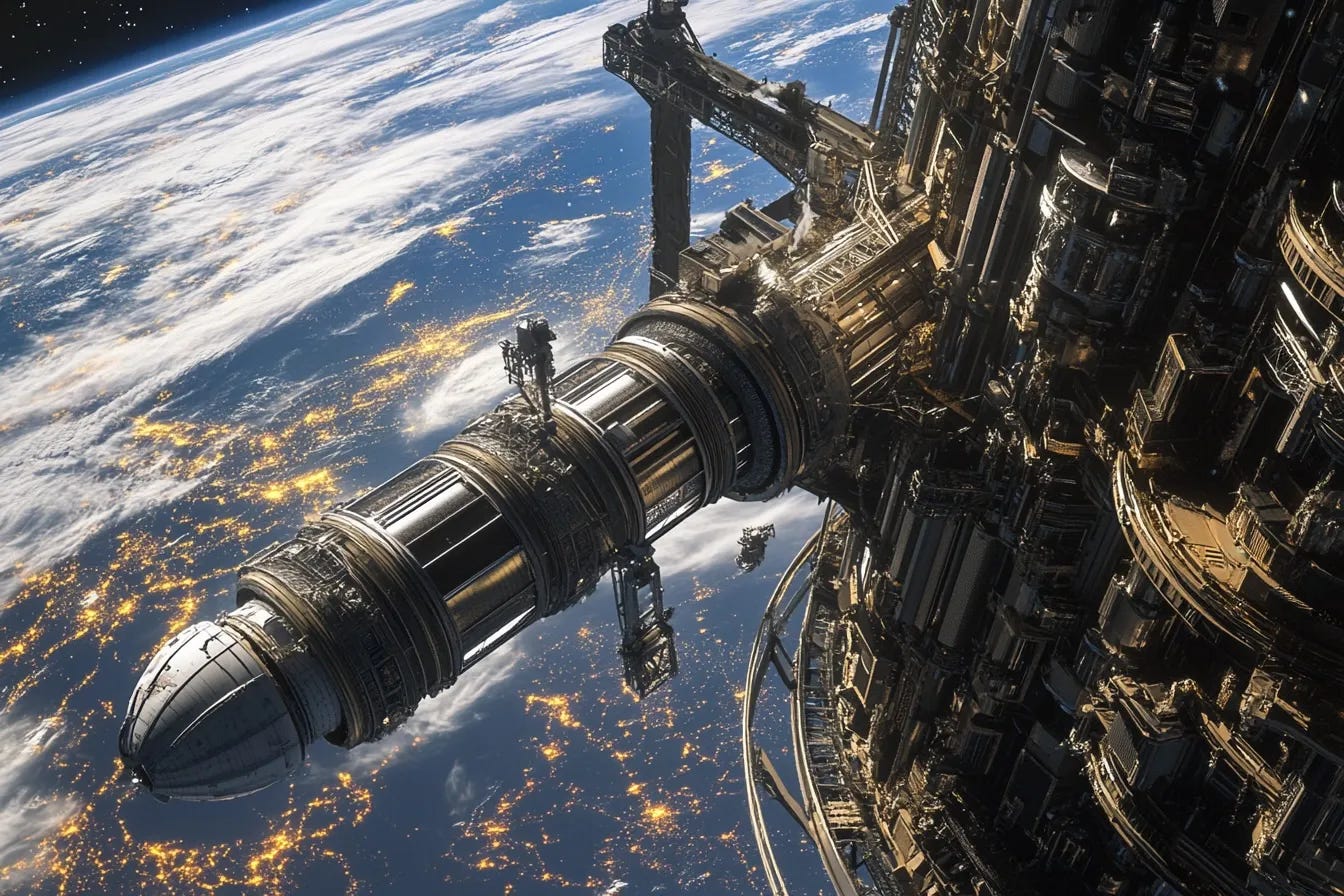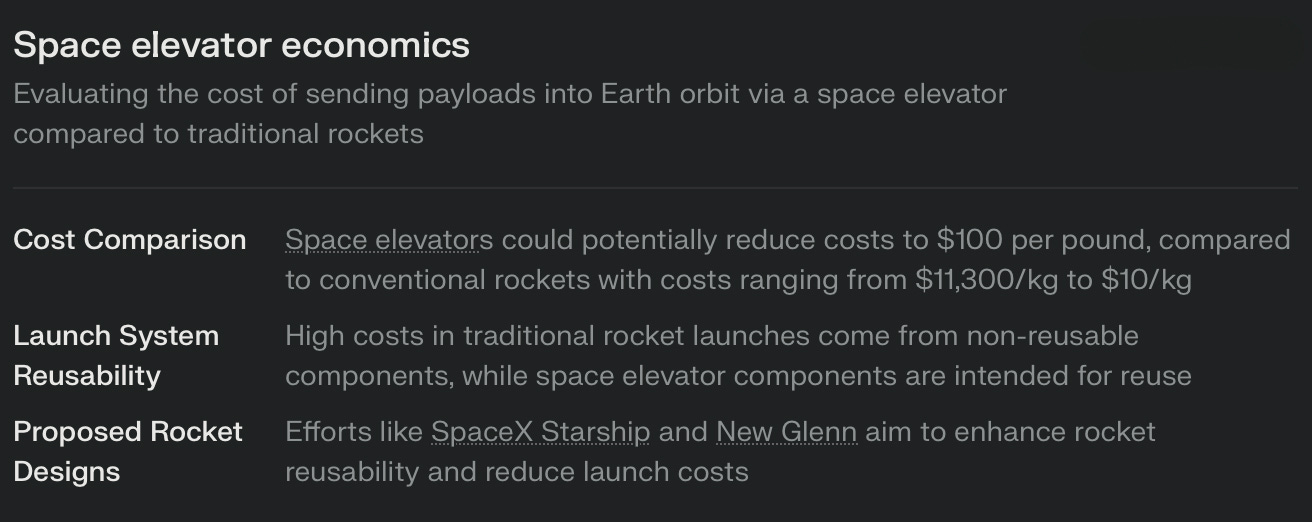Arthur C. Clarke’s 1979 novel “The Fountains of Paradise” introduced the world to the concept of a space elevator, revolutionizing space travel. Now, what once seemed purely fictional is closer to reality, as scientists and engineers work to overcome the challenges of constructing such a monumental structure.
Space elevators promise to reduce the cost and environmental impact of space launches, potentially opening up a new era of space exploration and commerce. But the path from concept to reality is littered with obstacles, from the need for revolutionary materials to the complex engineering required to build and maintain a structure potentially reaching tens of thousands of kilometers into space.
How realistic are space elevators, what research is underway, and what elevator music will they play? Lets dig a little deeper.
The Fountains of Paradise
In "The Fountains of Paradise", Clarke envisions a 22nd-century world where a space elevator, or “orbital tower,” is constructed. This structure connects the Earth’s surface to a satellite in geostationary orbit, approximately 36,000 kilometers above the equator. Clarke’s fictional space elevator is made possible by a strong and lightweight material called “hyperfilament,” which he later suggested could be realized through the use of carbon-based materials like Buckminsterfullerene or carbon nanotubes.
Buckminsterfullerene, also known as C₆₀, is a molecule composed of 60 carbon atoms arranged in a structure that resembles a soccer ball. It is part of a class of carbon-based molecules known as fullerenes. The molecule is named after the architect and inventor Buckminster Fuller, who designed geodesic domes, because its structure resembles the geodesic domes he popularized. It is highly symmetrical, which contributes to its strength and resilience. Amongst other applications, Fullerenes, including C₆₀, are being explored for use in nanotechnology, particularly in the development of nanomaterials and molecular electronics.
Science Fiction vs. Current Research
Arthur C. Clarke’s Vision:
Material Science: Clarke’s concept relied on a hypothetical material called hyperfilament, which needed to be incredibly strong and lightweight to support the elevator’s structure.
Conceptual Framework: Clarke’s space elevator was a monumental engineering project that required overcoming significant technological and political challenges. The novel explores themes of human ingenuity and the drive to push technological boundaries.
Current Research and Developments:
Feasibility and Materials: Carbon nanotubes and other advanced materials are being studied for their strength and lightweight properties, although a fully suitable material has yet to be developed.
Engineering Challenges: The concept of a space elevator is theoretically feasible, but practical implementation faces significant challenges. These include the need for a material that can support its own weight over vast distances and withstand environmental forces.
Economic and Environmental Benefits: A space elevator could drastically reduce the cost of sending payloads into space, making space travel more accessible and reducing environmental impacts compared to traditional rocket launches.
Timeline and Costs: Estimates suggest that building a space elevator could cost around $10 billion and take 15 years to construct [Bradley Edwards, who researched the concept for NASA about 20 years ago]. Once operational, it could reduce the cost of sending payloads to space to as low as $100 per pound - more on this later.
So current research is gradually addressing the technical challenges that could one day make space elevators a reality.
More Space Elevator Challenges
Manufacturing Challenges
While carbon nanotubes have the necessary tensile strength theoretically, producing them in the required quantities and quality remains a significant hurdle. The synthesis of carbon nanotubes with consistent properties and in large enough quantities is still a work in progress.
Researchers are exploring ways to improve the manufacturing processes to make carbon nanotubes a viable option for tethers .
Technological and Logistical Hurdles
Beyond the material science of the tether, the construction of a space elevator involves the design of the actual elevator, the construction of a base station, and the management of environmental factors such as weather and space debris.
The estimated cost and time frame for constructing a space elevator are significant. For instance, a more recent estimate by Japan’s Obayashi Corporation has proposed a timeline of 25 years with an estimated cost of $100 billion.
Research and Development
Organizations like NASA and various international consortia are actively researching the feasibility of space elevators and the potential use of carbon nanotubes.
The International Space Elevator Consortium is working on the theoretical and practical aspects of space elevators, with projections for initial operations in the last half of the 2030s.
Anchoring a space elevator on the moon
There are suggestions that anchoring a space elevator on the Moon, rather than Earth, offers several advantages that improve its feasibility:
Reduced Gravitational and Centrifugal Forces
Lower Gravitational Pull: The Moon’s gravitational pull is significantly weaker than Earth’s, which means that the materials required to construct a lunar space elevator do not need to withstand as much force. This allows for the use of existing materials, such as Kevlar or Zylon, which are strong enough to support a lunar space elevator but not an Earth-based one.
Centrifugal Forces: A space elevator anchored on Earth would need to rotate with the planet, experiencing substantial centrifugal forces that no current material can withstand. In contrast, a lunar space elevator would orbit much more slowly, reducing these forces to manageable levels.
Stability and Construction
Lagrange Points: The lunar space elevator would pass through a region where Earth’s and the Moon’s gravitational forces cancel each other out, known as a Lagrange point. This provides a stable area for construction and reduces the risk of the cable being pulled too strongly in either direction.
Tidal Locking: The Moon is tidally locked with Earth, meaning it always shows the same face to our planet. This stability eliminates the relative motion issues that would complicate an Earth-anchored elevator, making the lunar option more feasible.
Economic and Practical Benefits
Cost-Effectiveness: Building a lunar space elevator is estimated to be less expensive than constructing an Earth-based one. The project could potentially be completed for a few billion dollars, which is within the reach of current space budgets and private investments.
Reduced Fuel Requirements: A lunar space elevator would significantly lower the fuel needed to transport materials to and from the Moon, thus reducing costs and making lunar exploration and exploitation more economically viable.
So, anchoring a space elevator on the Moon leverages the Moon’s lower gravity and the stability provided by Lagrange points, making it a more feasible and cost-effective option than an Earth-based elevator with current technology.
Timeline and Future Prospects
While the concept of a space elevator is gaining traction and research is advancing, it is likely that we are still decades away from seeing a fully operational space elevator. Estimates suggest that a material solution might be found within the next 10 years, but practical implementation will take longer.
So Where Does That Leave Us? - Waiting for the elevator to arrive!
... and the elevator music...
"Rocket Man" by Elton John
"Fly Me to the Moon" by Frank Sinatra
... and obviously "Space Oddity" by David Bowie
*** Feel free to drop your own suggestions in the comments ***
Takeaways
1.Historical Context: Arthur C. Clarke’s novels popularized the idea of space elevators, providing a visionary framework that continues to inspire researchers and engineers.
2. Material Science Challenges: The development of ultra-strong, lightweight materials like carbon nanotubes is crucial for the feasibility of space elevators. While progress has been made, we have yet to produce materials that fully meet the demanding requirements.
3. Current Research: Although no functional prototypes exist, various organizations and researchers are actively working on conceptual designs and tackling the associated engineering challenges.
4. Lunar Alternative: The concept of a lunar-anchored space elevator has advantages, including reduced gravitational stress and potentially lower construction costs, making it a promising alternative to Earth-based designs.
5. Future Prospects: While estimates vary, the consensus is that a functional space elevator is still decades away. However, ongoing research continues to bring us closer to this goal.
6. Potential Impact: If realized, space elevators could revolutionize space travel by dramatically reducing costs and environmental impacts, potentially opening up new frontiers in space exploration and commerce.
More Reading
https://www.scientificamerican.com/article/space-elevators-are-less-sci-fi-than-you-think/
https://uk.news.yahoo.com/space-elevators-could-us-mars-174354725.html
https://news.northeastern.edu/2024/02/01/are-space-elevators-possible/
https://axess2.co.uk/the-potential-of-space-elevators-for-future-space-travel/
https://phys.org/news/2024-02-space-elevators-physicist-humanity-spacefaring.html
https://www.dezeen.com/2024/01/09/jordan-william-hughes-space-elevator/
https://news.northeastern.edu/2024/02/01/are-space-elevators-possible/
https://www.studysmarter.co.uk/explanations/engineering/aerospace-engineering/space-elevators/
https://universemagazine.com/en/construction-of-space-elevator-is-delayed-for-25-years/
https://www.sciencedirect.com/science/article/abs/pii/S0094576522004295
https://ntrs.nasa.gov/api/citations/20060000015/downloads/20060000015.pdf
https://www.reddit.com/r/space/comments/8v7ssh/feasibility_of_a_moon_space_elevator/
https://en.wikipedia.org/wiki/Space_elevator_economics









Arthur C. Clarke’s Space Elevators vs. Real World